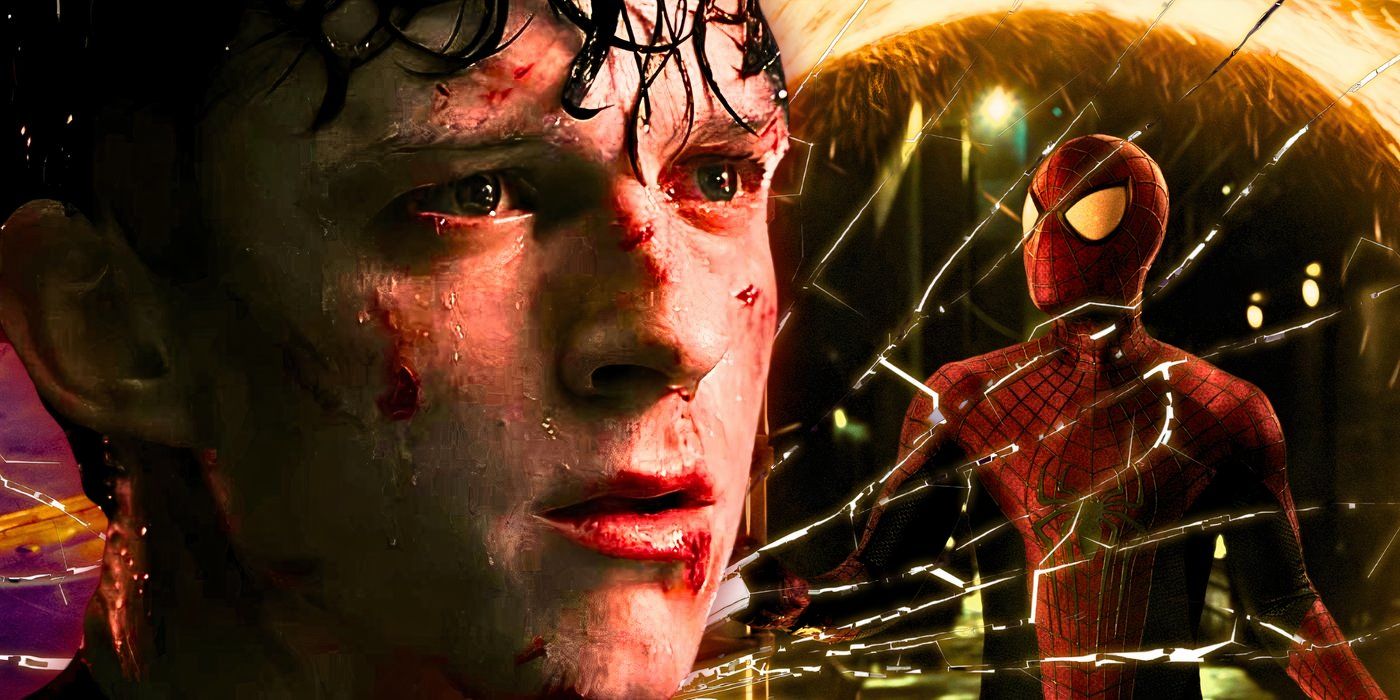
The events of Spider-Man: No Way Home cemented a heartbreaking record for Tom Holland’s Spider-Man. Despite the excitement that was caused by No Way Home‘s multiversal plot, the film possesses somewhat of a tragic core. Although the cast of Marvel characters in No Way Home united Tobey Maguire, Tom Holland, and Andrew Garfield, the final minutes of the film rank among some of the bleakest in the entire MCU Spider-Man timeline.
It is worth noting that the final scene of Spider-Man: No Way Home is fantastic, and perfectly sets up a continuation of the character in the MCU’s Spider-Man 4 story. That said, the moments before this solidified No Way Home, and the two movies preceding it, as a pseudo-Spider-Man origin story in the MCU. Through these sequences and the stories of Maguire and Garfield’s Spider-Men, Spider-Man: No Way Home solidified Tom Holland’s Peter Parker as the holder of an unwanted, tragic record.
No Way Home’s Villain Arcs Make Maguire & Garfield’s Timelines Much Happier
The Ending Of No Way Home Is Significantly Happier For Maguire & Garfield

Firstly, it is worth exploring how the stories of Tobey Maguire and Andrew Garfield’s Spider-Men provide context to Holland’s record. At the end of the film, Maguire and Garfield’s characters are sent back to their respective universes by Doctor Strange. They are accompanied by the villains who also traveled to the mainline MCU; Doctor Octopus, Sandman, and Green Goblin travel home with Tobey Maguire’s Spidey, while Electro and Lizard make the magical journey with Garfield’s Pete.
An interesting point, however, is that each character returns back to the same point from which they left their timelines. The villains each return to their respective universes at crucial points in Sam Raimi’s Spider-Man trilogy and Marc Webb’s The Amazing Spider-Man films. After the Spider-Man: No WayHome‘s events, these villains are now cured. Norman Osborn returns to 2002’s Spider-Man right before he dies, only as a sane man. The same can be said for Sandman, Doc Ock, Electro, and Lizard.
This will surely change the status quo of both universes drastically. Maguire’s Peter Parker now has people who were once his friends, such as Norman and Otto Octavius, back in his life, while the butterfly effect from Electro being cured in The Amazing Spider-Man 2 could save the life of Gwen Stacy. Regardless, the villains being cured in No Way Home allow Maguire and Garfield’s universes to be much happier than they were in each film series. These could provide the basis for Spider-Man 4 or The Amazing Spider-Man 3, two long-desired projects.
Tom Holland’s Spider-Man Is Left At His Lowest Point In No Way Home
The MCU’s Peter Parker Has Never Been Lower

On the flip side of this coin is Tom Holland’s Peter Parker. As a result of Doctor Strange’s No Way Home spell, every single person in existence forgot that Peter Parker exists. Through this sacrifice, Peter lost his girlfriend MJ. Furthermore, Peter’s closest friends like Ned, Happy Hogan, and Strange himself forgot who Peter was. This is without mentioning previous people Peter has lost, from Tony Stark and Uncle Ben to Aunt May. All of this puts Peter in the darkest possible position he can be.
Peter’s lonely life gives Spider-Man 4 the opportunity to introduce other Spider-Man characters like Harry Osborn and Gwen Stacy.
This is only added to by Peter’s new life. As alluded to, no one knows he exists, meaning all semblance of his old life has disappeared. This leads Peter to rent a new apartment, one which is depicted as rundown and desolate in the heart of New York. While Peter’s final swing scene proves how his life as Spider-Man will continue in spite of his new circumstances, there is no denying that the end of Spider-Man: No Way Home leaves Peter at his lowest point, in stark contrast to the much happier universes of Tobey Maguire and Andrew Garfield’s Spider-Men.
There’s Still Time For The MCU’s Spider-Man To Find Happiness
Peter’s Low Point Sets Up Future MCU Stories

Ironically, Tom Holland’s end-point in No Way Home is the one Spider-Man fans tend to latch onto. Spider-Man is often a character who is so relatable and likable due to his ability to fight for what is right despite often living a poor life as Peter Parker. As such, the ending of No Way Home was incredibly well-received. On top of this, it simply makes sense to leave MCU Peter off at his lowest point rather than the other Spider-Men. Maguire and Garfield are at the end of their journeys, at least until Avengers: Secret Wars if rumors are to be believed.
The happier endings for both characters thus provide a sense of closure. With Holland’s Peter, his low point offers more storytelling and character potential for the future of the MCU. More adventures will come in the MCU for Spider-Man, giving him the opportunity to build himself back up and become happier once more. This means that – despite holding the current record for being the most tragic iteration of the character after Spider-Man: No Way Home – the future still looks bright for the MCU’s Web-Slinger.





